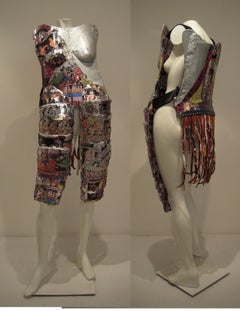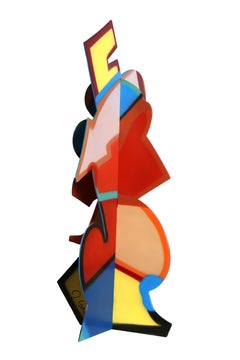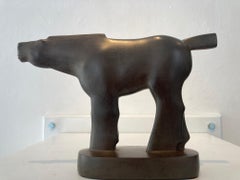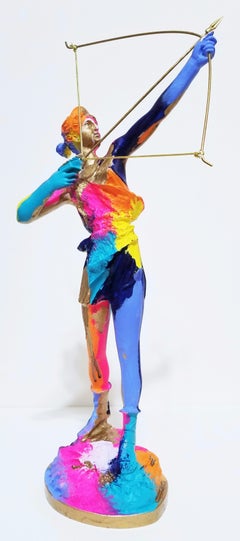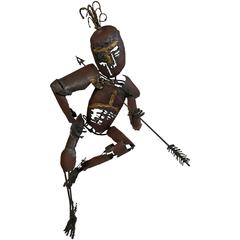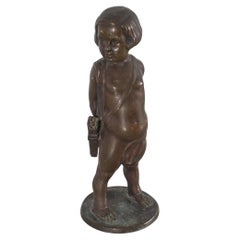Arrow Sculpture
to
9
125
31
63
62
46
25
22
22
9
8
8
7
7
6
3
3
3
2
2
2
2
1
1
1
1
1
1
1
1
1
16
11
5
5
4
Sort By
Arrow Knight 670 - Contemporary Mixed Media Wearable Performance Sculpture
Located in New York, NY
Arrow Knight 670 is from Linda Stein's Body-Swapping Armor series. These wearable sculptures are
Category
Early 2000s Contemporary Abstract Sculptures
Materials
Metal
$36,000 Sale Price
20% Off
H 62 in W 22 in D 14 in
Untitled (Arrows), Graffiti Sculpture by John Crash Matos
By John Crash Matos
Located in Long Island City, NY
A unique spray painted cut steel sculpture by New York Graffiti artist, John "Crash" Matos. signed
Category
2010s Street Art Abstract Sculptures
Materials
Steel
$7,500
H 33 in W 14.5 in D 11.5 in
Arrow, Large Pop Art Brushed Steel Sculpture by Paul von Ringelheim
By Paul von Ringelheim
Located in Long Island City, NY
Arrow
Paul von Ringelheim, Austrian/American (1933–2003)
Date: circa 1968
Steel Sculpture
Size: 98
Category
1960s Pop Art Abstract Sculptures
Materials
Steel
Price Upon Request
H 98 in W 27 in D 8 in
Kiowa Iron Tipped Medicine Arrows
Located in Colorado Springs, CO
Signed/etched by Artist on the bronze base of the piece with an edition number.
3/30
Category
21st Century and Contemporary Realist Sculptures
Materials
Bronze
Zoals Een Pijl Arrow Bronze Figurative Horse Sculpture Geometric In Stock
By KOBE
Located in Utrecht, NL
Zoals Een Pijl Arrow Bronze Figurative Horse Sculpture Geometric In Stock
KOBE, pseudonym of
Category
21st Century and Contemporary Contemporary Figurative Sculptures
Materials
Bronze
$5,925
H 6.7 in W 9.85 in D 2.37 in
Diana Sculpture II /// Contemporary Pop Street Art Hunt Figurative Bow and Arrow
By Jack Graves III
Located in Saint Augustine, FL
Artist: Jack Graves III (American, 1988-)
Title: "Diana Sculpture II"
Series: Sculpture
*Signed
Category
2010s Contemporary Figurative Sculptures
Materials
Cast Stone, Marble
$1,000
H 17 in W 6.88 in D 6 in
Diana with an arrow
By Albert-Ernest Carrier-Belleuse
Located in PARIS, FR
Diana with an arrow
by Albert-Ernest CARRIER-BELLEUSE (1824-1887)
Bronze sculpture with a dual
Category
1870s French School Nude Sculptures
Materials
Bronze
$15,169
H 32.68 in W 17.72 in D 11.82 in
Mid-Century Modern Brutalist Sculpture "Man with Arrow" Fantoni
By Marcello Fantoni
Located in Buffalo, NY
Wonderful Hand made,welded brutalist sculpture depicting man removing arrow,, Artist unknown but
Category
20th Century American Brutalist Figurative Sculptures
Materials
Iron
Sculpture of a child with arrows in solid bronze signed. 1920s
By Lorenz
Located in Palermo, IT
Valuable bronze sculpture depicting a child with arrows. On the base the incuse signature not
Category
Vintage 1920s Italian Modern Figurative Sculptures
Materials
Bronze
Framed Collection of Mesoamerican Pre-Classic Period Sculptures & Arrow Heads
Located in New York, NY
Incredible collection of pre-columbian clay sculptures / figures / statues / pottery, mounted and
Category
Antique 15th Century and Earlier North American Pre-Columbian Figurative...
Materials
Hardwood, Precious Stone, Clay
$7,790
H 29.5 in W 15.5 in D 1.5 in
Abstract "Split Decision" Artography Arrow Wall Sculpture by Pasqual Bettio
By Pasqual Bettio
Located in Van Nuys, CA
Artography wall sculpture titled "Split Decision" Artography Wall Sculpture by Pasqual Bettio. Bio
Category
Vintage 1930s American Wall-mounted Sculptures
Materials
Wood
$7,475 Sale Price
25% Off
H 25 in W 25 in D 3 in
Arco II - Bronze Figure Poised Shooting an Arrow, Verdigris Patina, Steel Base
By Jesus Curia Perez
Located in Chicago, IL
in sculpture with the focus on the human body. The interpretation of the movement and emotions should
Category
21st Century and Contemporary Contemporary Figurative Sculptures
Materials
Bronze, Steel
$9,000
H 26 in W 17.75 in D 7.75 in
Carl Kauba "Indian with Bow & Arrow", Signed Kauba
Located in West Palm Beach, FL
Carl Kauba (1865-1922)
"Indian with Bow & Arrow",
signed Kauba.
Warm bronze patina,
mounted
Category
20th Century Figurative Sculptures
Materials
Bronze
19th Century Bronze Grand Tour Neoclassical Souvenir Cupid Making an Arrow
Located in Palm Springs, CA
A lovely bronze neoclassical Grand Tour Souvenir depicting Cupid fashioning and arrow on his anvil
Category
Antique Late 19th Century Italian Figurative Sculptures
Materials
Bronze
$1,130
H 10 in W 12 in D 6 in
Sculptural 18th Century Italian Mecca Arrow on a Polished Calcite Base
By Interi
Located in Dublin, Dalkey
18th-century distressed Italian mecca arrow with a baroque pearl on a polished calcite base.
The
Category
Antique 18th Century Italian Rococo Figurative Sculptures
Materials
Rock Crystal, Gold Leaf
$712 Sale Price
25% Off
H 7.25 in W 3.75 in D 1.75 in
Antique French Cabinet Size Bronze of Cupid with a Quiver of Arrows
By Jean Marie Pigalle
Located in Philadelphia, PA
A finely modeled, cabinet-sized sculpture.
In the style of Jean-Marie Pigalle.
Cast in bronze
Category
Antique Late 19th Century Unknown Neoclassical Figurative Sculptures
Materials
Bronze
Maison Baguès Style Pair of French Arrow Bronze Sconces
By Maison Baguès
Located in Atlanta, GA
This elegant pair of French bronze arrow sconces captures the timeless sophistication of Maison
Category
Antique 19th Century French Wall-mounted Sculptures
Materials
Bronze
Antique Meissen Porcelain Figurine of Cupid Holding an Arrow & Flaming Heart
By Meissen Porcelain
Located in Hamilton, Ontario
seated on a stump, holding an arrow with an outstretched hand, and cradling a flaming heart with the
Category
Antique Mid-19th Century German Romantic Figurative Sculptures
Materials
Porcelain
$799
H 7.75 in Dm 3.75 in
Sculptural 18th Century Italian Mecca Gilt Arrow on a Polished Calcite Base
By Interi
Located in Dublin, Dalkey
18th-century distressed Italian mecca gilt arrow with a baroque pearl on a polished calcite base
Category
Antique 18th Century Italian Rococo Figurative Sculptures
Materials
Rock Crystal, Gold Leaf
$1,050
H 9 in W 3.5 in D 2 in
Outstanding Large Oak Carved Eagle Grasping Shield & Three Arrows
Located in Stamford, CT
Outstanding large oak carved eagle grasping shield with three arrows in his talons; most probably
Category
Antique Late 19th Century American Federal Sculptures and Carvings
Materials
Oak
18th Century Italian Mecca Arrow with a Baroque Pearl on a Polished Calcite Base
By Interi
Located in Dublin, Dalkey
18th-century Italian mecca arrow with a baroque pearl on a polished calcite base.
The arrow was
Category
Antique 18th Century Italian Rococo Figurative Sculptures
Materials
Rock Crystal, Gold Leaf
$712 Sale Price
25% Off
H 7.75 in W 3.5 in D 1.75 in
Rare 19th C. Chinese Nephrite Spinach Jade Carved Arrow Vase on Carved Wood Base
Located in New York, NY
An Incredible and Rare 19th Century Chinese Nephrite Spinach Jade Hand-Carved Arrow Vase with its
Category
Antique 19th Century Chinese Qing Sculptures and Carvings
Materials
Jade
$18,310 Sale Price
20% Off
H 6.75 in W 2 in D 1.5 in
Antique French Bronze Sculpture after Houdon
By Jean-Antoine Houdon
Located in London, GB
quiver of arrows in her hand. The sculpture is considered one of the finest works of French Neoclassicism
Category
Antique Late 19th Century French Neoclassical Figurative Sculptures
Materials
Bronze
Arrows by Piegatto A Contemporary Textile Sculpture
Located in Guatemala, GU
This captivating wall decor piece, titled Arrows, is a bold and stylish addition to any modern
Category
2010s Guatemalan Contemporary Art
Materials
Cotton, Silk, PVC
Vintage Bronze Gold and Green Thai Figurine of Prince Rama with a Bow
Located in North Hollywood, CA
Vintage bronze statue in gold and green of Prince Rama shooting an arrow.
The large bronze
Category
Mid-20th Century Thai Folk Art Sculptures and Carvings
Materials
Bronze
Stylish Empire Revival Six-Light Pendant Chandelier with Swan Heads and Arrows
Located in Lisse, NL
Stunning six-light pendant with gilt bronze arrows and swan head sculptures.
This top quality
Category
Early 20th Century French Empire Revival Chandeliers and Pendants
Materials
Brass, Bronze
$2,903
H 41 in Dm 24.75 in
Arrow Sculpture
By Wolfgang Roth
Located in Hudson, NY
the day and the Bauhaus School. As an artist, Roth's paintings, drawings, collages and sculpture often
Materials
Metal
The arrow Small Decoration Red Metal Sculpture Maite Carranza
Located in Madrid, MD
Red arrow sculpture. Geometry wrapping a space with a los of harmony.
Category
2010s Contemporary Abstract Sculptures
Materials
Brass
$948
H 16.54 in W 16.54 in D 16.54 in
20th Century Blue Iron Sculpture
Located in Saint-Ouen, FR
Blue arrows sculpture made of full iron.
Category
20th Century French Modern Abstract Sculptures
Materials
Iron
ERO - Metal Arrow Wall Art Sculpture
By ENNAIA
Located in Weslaco, TX
The arrow has a great symbolic meaning, related to elements of different natures such as protection
Category
2010s Abstract Geometric Abstract Sculptures
Materials
Steel, Stainless Steel
Chrome Arrow
By Alain Godon
Located in Beverly Hills, CA
Original Alain Godon Bronze sculpture of the New York Chrysler Building, with a chrome patina
Category
21st Century and Contemporary Contemporary Figurative Sculptures
Materials
Bronze
David Lemon Native American Large Bronze Sculpture Silent Arrow Signed Artwork
Located in Bloomington, MN
David Lemon Authentic & Large Original Bronze Sculpture "Silent Arrow", listed with the Submit Best
Category
20th Century Contemporary Figurative Sculptures
Materials
Bronze
$6,895
H 23.5 in W 19.5 in D 13.5 in
"Amber Arrow Buddha, " pigmented sand-cast glass sculpture, forged metal base
Located in Charlotte, NC
glass sculpture. Marlene’s work has a quality of timelessness reflecting both ancient and modern. Her
Category
21st Century and Contemporary Contemporary Figurative Sculptures
Materials
Metal
"This Way and That" an Original Metal Arrow Wall-Mounted Sculpture
By Tim Prendergast
Located in Palm Springs, CA
"This way and that." An original metal arrow wall sculpture by Tim Prendergast, circa 2013
Category
21st Century and Contemporary American Wall-mounted Sculptures
Antique Art Deco Bisque Sculpture of Mother and Child with Bow and Arrow
By Bohumil Rezl
Located in London, Greenwich
A beautiful original antique Art Deco sculptural figure of a mother and child with bow and arrow
Category
Vintage 1920s French Art Deco Figurative Sculptures
Materials
Porcelain
$942
H 12.6 in W 13.78 in D 4.73 in
Red Arrow Iron Found Object
Located in Palm Springs, CA
Red arrow iron found object on a black metal base.
Category
21st Century and Contemporary Mounted Objects
Materials
Iron, Metal
Pink Confetti- Paint, Wood, Mixed Media, Woven Wall Hanging, Sculpture
By Pam Marlene Taylor
Located in Nashville, TN
concepts of feminism and death through her work. She is represented by The Red Arrow Gallery in the state
Category
2010s Sculptures
Materials
Wood, Paint
Purple Confetti- Paint, Wood, Violet, Woven Sculptural Wall Hanging, Sculpture
By Pam Marlene Taylor
Located in Nashville, TN
concepts of feminism and death through her work. She is represented by The Red Arrow Gallery in the state
Category
2010s Sculptures
Materials
Wood, Paint
Yellow Confetti- Paint, Wood, Mixed Media, Woven Wall Hanging, Sculpture
By Pam Marlene Taylor
Located in Nashville, TN
concepts of feminism and death through her work. She is represented by The Red Arrow Gallery in the state
Category
2010s Sculptures
Materials
Wood, Paint
Clown Leg- Acrylic Paint, Ceramic, Oil Paint, Pattern, Text, Abstract, Sculpture
By Marlos E’van
Located in Nashville, TN
This ceramic sculpture is filled with brightly colored patterns and text.
From street art to
Category
2010s Sculptures
Materials
Ceramic, Oil, Acrylic
$1,000
H 14 in W 4 in D 9 in
Enter code to sacrifice something for the greater good (White-White)- Sculpture
By Pam Marlene Taylor
Located in Nashville, TN
represented in the state of Tennessee by The Red Arrow Gallery and is a graduate from Tusculum University
Category
2010s Sculptures
Materials
Yarn
Diana, Goddess of the Hunt with Bow and Arrow
By Rudolph Henn
Located in Brussels & Antwerp, BE
created in stone and bronze, his oeuvre included also small-scale bronze sculptures.
Henn exhibited in
Category
20th Century German Art Deco Figurative Sculptures
Materials
Marble, Bronze
Brutalist Yves Klein Blue Wood Wall Art installation: Arrows
By Studio DeSimoneWayland
Located in AMSTERDAM, NH
ARROWS Cobalt Blue (Yves Klein Blue) wall sculpture collage of reclaimed wood.
This artwork
Category
2010s Dutch Brutalist Wall-mounted Sculptures
Materials
Wood, Lacquer, Paint
Don't Rest Too Hard
By Lindsy Davis
Located in Nashville, TN
The Mollusk/ Fickle Comfort/ Don’t Rest too Hard: These three sculptures were made with the idea of
Category
2010s Contemporary Abstract Sculptures
Materials
Wood, Wax
Fickle Comfort
By Lindsy Davis
Located in Nashville, TN
The Mollusk/ Fickle Comfort/ Don’t Rest too Hard: These three sculptures were made with the idea of
Category
2010s Abstract Sculptures
Materials
Wood, Wax
Intimate by Proxy
By Lindsy Davis
Located in Nashville, TN
and works in Nashville, Tennessee. Lindsy is represented by Red Arrow Gallery.
Category
2010s Contemporary Abstract Sculptures
Materials
Thread, Wood, Wax
Intimate by Proxy
By Lindsy Davis
Located in Nashville, TN
and works in Nashville, Tennessee. Lindsy is represented by The Red Arrow Gallery.
Category
2010s Abstract Sculptures
Materials
Thread, Wood, Wax
Droop 1
By Lindsy Davis
Located in Nashville, TN
and works in Nashville, Tennessee. Lindsy is represented by Red Arrow Gallery.
Category
2010s Contemporary Abstract Sculptures
Materials
Wood, Wax
Stacked Shadow 3
By Lindsy Davis
Located in Nashville, TN
and works in Nashville, Tennessee. Lindsy is represented by Red Arrow Gallery.
Category
2010s Contemporary Abstract Sculptures
Materials
Wood, Wax
Brutalist Comb
By Lindsy Davis
Located in Nashville, TN
went home and immediately made this piece. It
was my first finished and fully realized sculpture piece
Category
2010s Contemporary Abstract Sculptures
Materials
Thread, Wood, Wax
Shaped Shadow 3
By Lindsy Davis
Located in Nashville, TN
Nashville, Tennessee. Lindsy is represented by Red Arrow Gallery.
Category
2010s Contemporary Abstract Sculptures
Materials
Wood, Wax
Shaped Shadow 2
By Lindsy Davis
Located in Nashville, TN
Nashville, Tennessee. Lindsy is represented by Red Arrow Gallery.
Category
2010s Contemporary Abstract Sculptures
Materials
Wood, Wax
Shaped Shadow 1
By Lindsy Davis
Located in Nashville, TN
Nashville, Tennessee. Lindsy is represented by Red Arrow Gallery.
Category
2010s Contemporary Figurative Sculptures
Materials
Wood, Wax
Unconditional- Mixed Media, Cotton, Thread, Woven Wall Hanging, Sculpture, Pink
By Pam Marlene Taylor
Located in Nashville, TN
Red Arrow Gallery. By day, she proudly wears the title of Museum Manager for 21c Museum Hotel
Category
2010s Abstract Mixed Media
Materials
Cotton, Thread
Tubes 2- Fabric, Yarn, Woven Wall Hanging, Sculpture, Green, Pink, Yellow
By Pam Marlene Taylor
Located in Nashville, TN
Tennessee by The Red Arrow Gallery. By day, she proudly wears the title of Museum Manager for 21c Museum
Category
2010s Feminist Mixed Media
Materials
Fabric, Yarn
Stunning Victorian Diamond Enamel Cherub Sentimental Brooch Pendant
Located in Napoli, IT
crafting of the era, 18 Kt gold , shell shaped, with winged Cherub lying in the centre snapping an arrow of
Category
Antique 1850s Victorian Brooches
Materials
Diamond, 18k Gold
Where I Wait For You
By Margie Criner
Located in Nashville, TN
Hanging crafter hornets nest sculpture with a mini diorama that can be seen through a viewfinder
Category
2010s Modern Still-life Sculptures
Materials
Wire
Far From Home
By Margie Criner
Located in Nashville, TN
Crafted wool and wood sculpture with a mini diorama that can be seen through a viewfinder
Category
2010s Modern Still-life Sculptures
Materials
Clay, Wool, Glass, Plastic, Wood, LED Light, Mirror, Found Objects, Arch...
- 1
Get Updated with New Arrivals
Save "Arrow Sculpture", and we’ll notify you when there are new listings in this category.
Arrow Sculpture For Sale on 1stDibs
Choose from an assortment of styles, material and more in our collection of arrow sculpture on 1stDibs. Frequently made of metal, wood and bronze, every piece of arrow sculpture was constructed with great care. There are 59 variations of the antique or vintage item from our selection of arrow sculpture you’re looking for, while we also have 7 modern editions of this piece to choose from as well. Your living room may not be complete without a choice in our collection of arrow sculpture — find older editions for sale from the 18th Century and newer versions made as recently as the 21st Century. An object in our assortment of arrow sculpture is a generally popular piece of furniture, but those created in Art Deco, Modern and Folk Art styles are sought with frequency. You’ll likely find more than one option in this array of arrow sculpture that is appealing in its simplicity, but Bend Goods, Interi and Carl Kauba produced versions that are worth a look.
How Much is a Arrow Sculpture?
A piece of arrow sculpture can differ in price owing to various characteristics — the average selling price 1stDibs is $1,150, while the lowest priced sells for $65 and the highest can go for as much as $29,166.
More Ways To Browse
Antique French Bronze Cherub
Bronze Putti
16th Century Carved
Chinese Carved Jade
Antique Cast Molds
Verdigris Decorative
Architectural Wall Hanging
Gypsum Furniture
Pair Bird Sculpture
Antique Carved Jade
Minton England
Chinese Carved Relief
Wooden Carved Figure Sculptures
Classical Marble Bust
Greek Terracotta
Hanging Sculptures
Decorative Glass Globes
Carved Wood Bow
